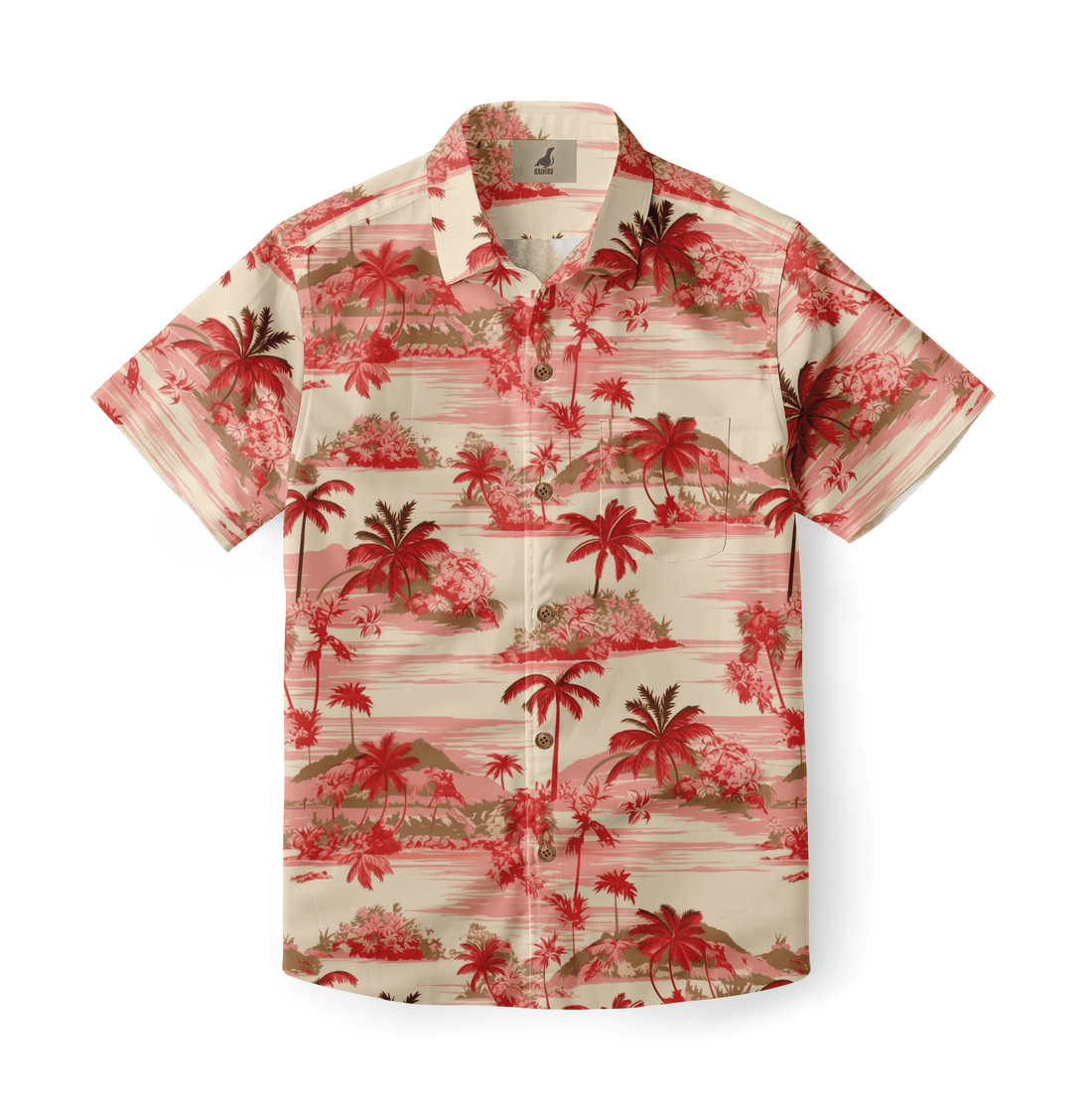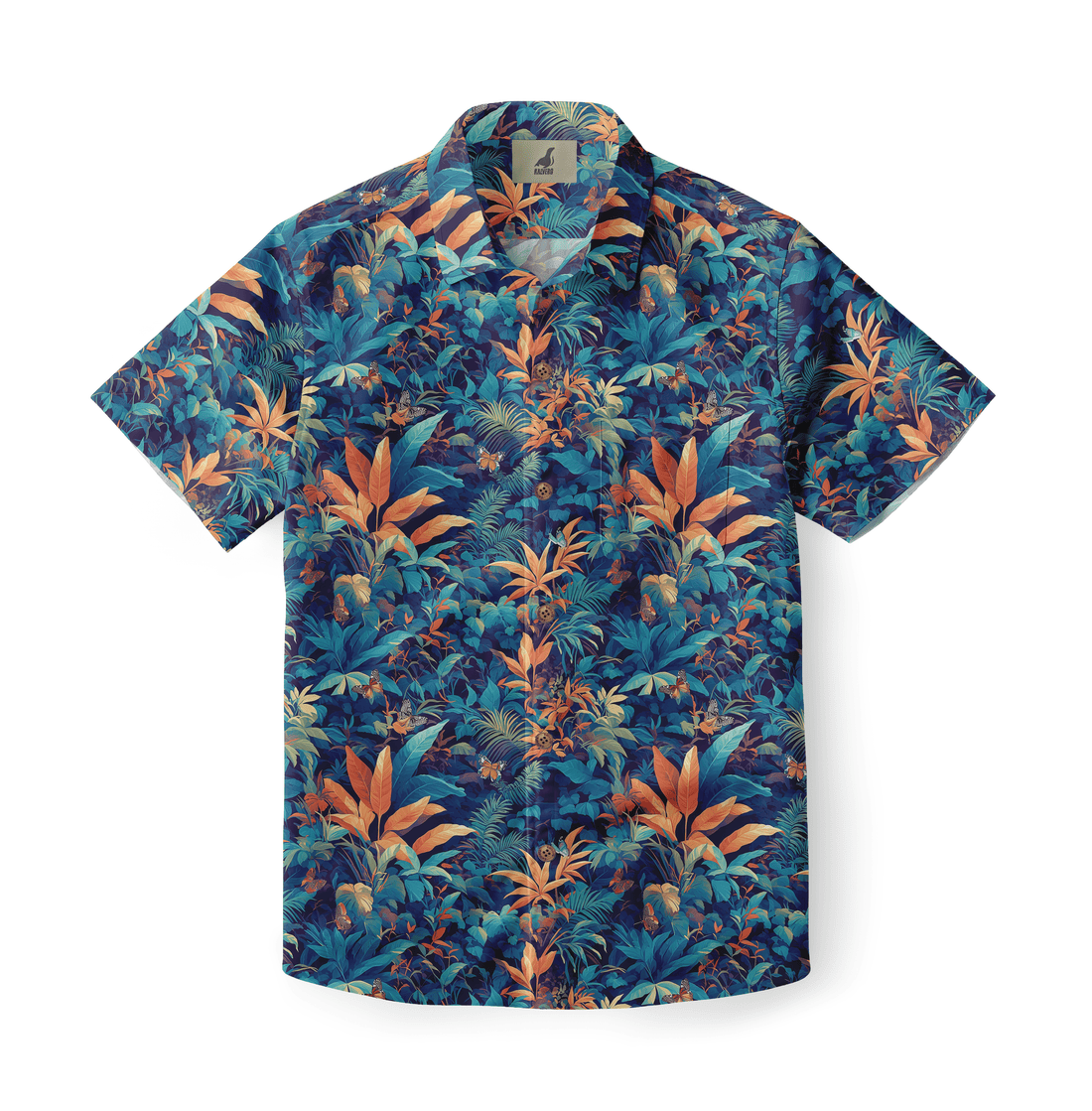Tropical Plants Behind Hawaiian Shirt Prints Explained centers on common island flora and their design roles. Designers pick specific plants for visual impact and cultural meaning. Hibiscus, plumeria, monstera, and palm fronds dominate many aloha shirt palettes. Each plant conveys a mood and a seasonal cue to buyers. Visual teams match motifs to target customers and resort contexts. Retailers use these plant cues to craft SEO tags and product descriptions. Color choices and motif scale determine shelf appeal and conversion. Understanding why designers select particular tropical plants helps brands plan assortments and merchandising. This core awareness drives better creative briefs and stronger customer connection to prints.
Tropical Plants Behind Hawaiian Shirt Prints Explained: Core Motifs and Meaning
Tropical Plants Behind Hawaiian Shirt Prints Explained reveals motif hierarchies and symbolic intent. Hibiscus often stands for island charm and casual leisure. Plumeria suggests scent, ceremony, and soft elegance for evening wear. Monstera and palm fronds signal tropical lushness and visual ease in busy patterns. Designers layer secondary elements like ferns and heliconia to add texture. Strategic placement of motifs guides the eye across a shirt panel. Brands often prioritize a hero botanical to anchor a color story. That hero then supports supporting leaves and small blooms for depth. Effective motif layering ensures that prints maintain readability across sizes and in photos.
Tropical Plants Behind Hawaiian Shirt Prints Explained: Botanical Origins and Local Sources
Tropical Plants Behind Hawaiian Shirt Prints Explained covers where motifs come from and how artists reference them. Many motifs originate from field studies of island gardens and wild coastal groves. Local artisans and botanical illustrators provide accurate leaf shapes and vein patterns. Some designs adapt botanical accuracy for stylized effect. Suppliers in production hubs replicate these motifs using vector art or hand-painting techniques. Authentic sourcing often involves collaboration with local communities or botanical gardens. When brands credit plant origins, customers perceive higher authenticity. Ethical reference practices respect cultural ownership while enabling global production at scale.
Tropical Plants Behind Hawaiian Shirt Prints Explained: Color, Scale, and Pattern Roles
Tropical Plants Behind Hawaiian Shirt Prints Explained clarifies how color and scale shape consumer perception. Bright hues highlight festive occasions and vacation moods. Muted palettes suit premium or heritage collections with vintage appeal. Larger motif scales read well on men’s sizes and hero garments. Smaller repeats work for fitted cuts and women’s blouses. Contrast between leaf tones and background color maintains visual legibility. Saturation choices alter perceived price and craftsmanship. Merch teams often test images under retail lighting to confirm color fidelity. Proper scaling and palette management make plant prints work across sizes and channels.
Common Tropical Species in Hawaiian Shirt Motifs
Designers favor a concise set of tropical plants for distinct visual roles. Hibiscus provides bold focal flowers and color pops. Plumeria offers rounded petals and soft romantic cues. Monstera presents dramatic split leaves and strong silhouettes. Palm fronds add linear rhythm and a sense of breeze. Heliconia and bird-of-paradise supply architectural shapes for dynamic layouts. Ferns and vines fill negative space and enhance texture. Each species carries a familiar visual language that shoppers recognize. Selecting a small palette of species improves cohesion across a seasonal collection and simplifies cross-merchandising choices.
How Print Techniques Affect Plant Representation
Print technique determines how plant textures and colors translate to fabric. Screen printing delivers dense, tactile color and layered effects. Digital printing renders fine vein details and soft gradients precisely. Reactive dyeing bonds color into cellulose for durability and colorfastness. Pigment printing sits on the fabric surface and can weather differently. Each method changes motif clarity and the way light interacts with color. Designers choose techniques based on fabric type and price point. Prototyping with the intended method prevents surprises in bulk production. That step ensures botanical details survive scale adjustments and washing cycles.
Cultural Context and Symbolism of Island Flora
Island flora carry social and ceremonial meanings that affect print acceptance. In many Pacific cultures, plumeria links to ritual adornment and personal identity. Hibiscus can signify local pride and casual friendliness in tourist-facing designs. Palm fronds often evoke shade, leisure, and coastal life. Misusing sacred elements risks cultural insensitivity in global markets. Brands should consult cultural advisors before using particular motifs in sensitive contexts. Transparent storytelling about plant symbolism enhances customer connection. When executed respectfully, prints that reference island flora honor heritage while appealing broadly.
Sourcing, Sustainability, and Dyeing Practices
Sourcing tropical motifs responsibly matters to conscious buyers and global brands. Using low-impact dyes minimizes wastewater and reduces chemical loads. Recycled fibers and eco-friendly finishes affect how pigments bond and appear. Some mills provide certified dyehouses and documented effluent treatment. Fair labor practices in print workshops contribute to brand reputation. Brands should request mill certificates and independent audits when scaling production. Sustainable choices sometimes require different art adjustments to preserve vibrancy. Communicating sustainability measures alongside plant stories builds buyer trust and supports premium positioning.
List of Practical Design Tips for Using Tropical Plants
-
Anchor prints with a dominant botanical element
-
Use secondary foliage to control negative space
-
Scale motifs for intended size ranges and fits
-
Select printing methods that preserve botanical detail
-
Test swatches under retail and daylight lighting conditions
Design Advantages and Merchandising Applications
The List of Practical Design Tips for Using Tropical Plants shows actionable steps for teams. Anchoring prints with a dominant plant clarifies the pattern hierarchy. Secondary foliage fills gaps and reduces visual chaos on small sizes. Correct scaling prevents motif loss on fitted garments. Choosing a printing method that preserves detail protects brand integrity. Swatch testing across lighting conditions prevents mismatches in photographs and stores. Applying these tips simplifies production decisions and improves runway-to-rack consistency for seasonal collections.
Comparative Traits Table of Iconic Tropical Plants
| Plant | Visual Cue | Common Use |
| Hibiscus | Large bloom, bold color | Hero pieces, resortwear |
| Plumeria | Rounded petals, soft tones | Evening resort, feminine lines |
| Monstera | Split leaf silhouettes | Graphic patterns, unisex pieces |
| Palm Frond | Linear rhythm, airy feel | Background fills, casual shirts |
Comparative Traits Table of Iconic Tropical Plants
The Comparative Traits Table of Iconic Tropical Plants helps buyers and designers align motifs to product roles. Hibiscus serves as a focal flower for high-impact garments. Plumeria works for softer, intimate silhouettes. Monstera creates graphic appeal suitable for unisex marketing. Palm fronds provide movement and background texture across casual ranges. Using this table during assortment planning streamlines brief creation. Teams can match motif roles to production processes and expected price tiers. That alignment reduces sampling cycles and supports clearer merchandising narratives.
How Brands Tell Plant Stories on Product Pages
Brands translate botanical cues into persuasive product storytelling on pages. Descriptions that mention plant names and color intent help search and shopper context. High-quality close-ups of motif detail support trust and reduce returns. Filter tags that reference key plants improve discovery and relevance. Packaging notes that echo plant narrative strengthen the unboxing experience. Seasonal editorial content connecting prints to locations increases perceived authenticity. Combining accurate botanical references with clear photography enhances conversion. Product pages therefore act as a primary channel for conveying motif value and origin.
Styling, Fit, and Product Photography for Plant Prints
Styling choices alter how prints read across body types and occasions. Tucking a bold print into neutral bottoms reduces visual intensity for daily wear. Layering with tonal pieces allows a print to serve as accent rather than statement. Photography should include close-ups for detail and distant shots for overall scale. Lighting must reveal true colors and avoid glare that washes out motifs. Model selection affects perceived wearability and demographic fit. Consistent styling rules ensure customers visualize occasions and reduce uncertainty before purchase.
The Psychology of Plant Motifs and Consumer Appeal
Plant motifs trigger associative memory and mood-related responses in buyers. Tropical images often evoke relaxation, travel, and escape, which influence purchase intent. Bright botanical prints tend to increase impulse buys for vacation shoppers. Calmer palettes attract buyers seeking everyday versatility. Motif scale signals price and occasion cues subconsciously to shoppers. Brands that test motifs through small drops collect direct feedback for refinement. Data-driven iteration integrates visual appeal with category economics for lasting success.
Final Takeaways on Tropical Plants and Print Design
Tropical Plants Behind Hawaiian Shirt Prints Explained highlights design, culture, and commerce intersections. Effective motifs balance botanical accuracy with stylized readability for fabric. Sustainable production choices and clear provenance enhance authenticity claims. Testing colors, scales, and print methods prevents surprises in full production. Narrative-rich product pages and careful merchandising increase conversion and decrease returns. Cohesive plant strategies across seasons help brands maintain consistent identity and customer loyalty. Thoughtful use of island flora turns casual shirts into meaningful visual statements that sell.
Frequently Asked Questions
How do designers choose which tropical plants to feature in Hawaiian shirt prints?
Designers select plants based on visual impact, cultural resonance, and wearability. They prioritize a hero botanical that defines the color palette and layout. Secondary foliage and accent blooms balance negative space and prevent crowding. Sampling under retail lighting verifies color fidelity and scale. Designers also consider target demographics and occasion use to match motif boldness. Practical constraints such as printing method and fabric also influence choices. Consultation with botanical illustrators or local experts ensures shapes and vein patterns remain recognizable. This process combines aesthetics, production realities, and audience data to yield effective prints.
Are real plant motifs necessary for authentic Hawaiian shirt design?
Authenticity often benefits from accurate plant references, but stylization also plays a valid role. Real motifs strengthen cultural connection and resonance for customers familiar with island flora. Stylized versions, however, can evoke mood and broaden market appeal when used respectfully. Many brands balance botanical fidelity with creative interpretation to achieve both recognition and novelty. Proper attribution and sensitivity to cultural meaning prevent misappropriation. When brands incorporate genuine plant cues while acknowledging origin, they create authentic products that respect heritage and satisfy diverse global buyers.
What sustainability steps should brands take when producing plant-themed shirts?
Brands should vet dyehouses for low-impact processes and documented effluent treatment. Choosing reactive dyes and certified mills reduces environmental harm. Using recycled or organic fibers alters dye uptake, so testing is essential. Fair labor practices in print workshops matter as much as chemical compliance. Brands can source motifs from local artists to support community economies and maintain provenance. Transparency about material sourcing and third-party certifications builds buyer trust. Small-batch testing and clear sustainability claims help brands charge premiums while reducing reputational risk.








